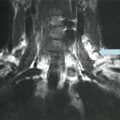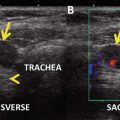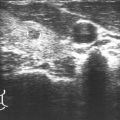© Springer International Publishing Switzerland 2016
David S. Cooper and Cosimo Durante (eds.)Thyroid Cancer10.1007/978-3-319-22401-5_3232. RAI-Refractory Differentiated Thyroid Cancer with Multiple Organ Progressive Disease
(1)
University of Texas MD Anderson Cancer Center, Unit 1461, 301402, Houston, TX 77230-1402, USA
Keywords
Thyroid carcinomaMetastasesRadioiodine refractoryKinase inhibitorRedifferentiationChemotherapyCase Presentation
A 55-year-old woman presented to the clinic for consideration of treatment for progressive metastases from follicular thyroid carcinoma. She had undergone a total thyroidectomy and adjuvant radioiodine at age 47 for a 3.5 cm tumor. Given persistently abnormal serum thyroglobulin levels, she received two additional radioiodine treatments for a cumulative 131I therapeutic activity of 360 mCi, but her third posttreatment scan was negative. A chest computed tomography (CT) was then performed, which demonstrated several subcentimeter lung nodules bilaterally. Subsequent growth of these nodules led to resection of two from the left lung, with pathology consistent with metastatic follicular carcinoma. One year earlier, she received a fourth treatment with radioiodine, 210 mCi, with no uptake noted in multiple lung nodules that measured between 1 and 2 cm on chest CT. Although she denied symptoms from her lung metastases such as hemoptysis or dyspnea and her physical exam yielded no evidence of her malignancy, her most recent chest CT now showed lesions that were 30–40 % larger in diameter than the previous year. Her serum thyroglobulin level was 925 ng/mL, with a concurrent TSH of 0.01 mU/L.
Literature Review
For patients with metastatic DTC who progress despite surgery, radioiodine, and TSH-suppressive thyroid hormone, systemic chemotherapy historically provided limited benefit and considerable morbidity. More recent efforts to apply biologically targeted therapies have emerged as promising approaches for progressive, radioiodine-refractory differentiated thyroid carcinoma (RR-DTC) , although side effects remain considerable and overall patient survival has not yet been demonstrated to improve with treatment.
Given that these systemic therapies for patients with progressive RR-DTC are not curative and can have significant toxicities, careful attention must be paid to appropriate patient selection for these treatments. The first priority is to identify which patients actually have “radioiodine-refractory” and “progressive” disease [1, 2]. Various definitions have been proposed for these characteristics, both in routine clinical practice as well as for eligibility criteria for clinical trials. An evolving standard is to combine scintigraphic imaging findings with clinical outcomes, defining radioiodine-refractory disease as meeting any of the following four criteria: tumors that are structurally evident on radiographic imaging that demonstrate no uptake on postthyroidectomy radioiodine imaging; tumors that previously concentrated radioiodine but no longer demonstrate uptake on subsequent scanning; mixed uptake, visualizing radioiodine concentration in some lesions but not others; and disease that progresses radiographically despite uptake of therapeutic radioiodine. Careful review of previous radioiodine imaging and preparation regimens must be performed before declaring a patient as “radioiodine refractory,” as proper dietary iodine restriction and TSH stimulation need to be assured to avoid false-negative imaging results. Finally, patients may have metastatic disease that could benefit from further treatments with radioiodine, but in whom the potential toxicity of additional radioiodine on bone marrow, pulmonary or salivary function is considered excessive and therefore radioiodine is no longer a reasonable treatment option.
“Progression” of disease also requires careful definition. For purposes of identifying patients who should be considered candidates for therapy beyond radioiodine, a combination of the extent of metastatic disease, the rate of growth of that disease, and the potential for morbidity related to further tumor growth all need to be considered [1, 2]. The extent of disease and rate of tumor growth can be assessed standardly by applying response evaluation criteria in solid tumors (RECIST) to serial CT or magnetic resonance (MR) imaging. The number and locations of “measurable” lesions at least 1 cm in diameter can be recorded, and the rate of progression can be determined by the percentage increase in the sum of the longest diameters of a representative subset of measurable lesions over a period of time. An emerging convention defines progressive disease warranting consideration of further therapy as metastatic lesions measuring at least 1–2 cm, with the sum of diameters increasing by at least 20 % over a 12 to 15-month period or the appearance of significant new metastatic lesions. The presence or absence of symptoms or complications from metastatic disease may modify the assessment. For example, a patient with a critically located vertebral metastasis may not be optimally managed by expectant observation if a minimal degree of growth threatens vertebral collapse, pain, or neurologic compromise. Similarly, a patient with extensive micrometastatic pulmonary disease that is growing very rapidly may also be considered for systemic therapy before reaching the 1–2 cm threshold.
In the setting of a limited number of progressing lesions, localized therapy can be considered. For example, palliative stereotactic radiotherapy can be administered to a patient with a painful skeletal metastasis or an enlarging pulmonary metastasis compressing a bronchus with excellent symptomatic benefit [3]. Radiofrequency and cryoablation are also useful for a variety of metastatic lesions in both soft tissue and bone.
However, the patient with multiple measurable, progressive, radioiodine-refractory metastases in one or more organs should now be considered for systemic therapy, usually with an orally administered kinase inhibitor [1]. Various kinases have emerged as potentially valuable targets for such inhibition in the treatment of cancer. In particular, proangiogenic receptors, such as the vascular endothelial growth factor receptor (VEGFR), fibroblast growth factor receptor (FGFR), and c-MET, have been demonstrated to be effective targets in the surrounding tumor microenvironment for treatment of several solid malignancies. In addition to being proangiogenic, these receptor kinases also have been identified on tumor cells themselves, thus providing a positive feedback loop by which the tumor secretes the stimulatory ligand, e.g., VEGF, that is capable of binding to the cognate receptor on the tumor cell, e.g., VEGFR, whose kinase signals upstream of multiple pro-proliferative cascades. Other oncogenic kinases, such as BRAF, are commonly mutated in papillary thyroid carcinoma and offer a second opportunity to target the tumor cell’s growth pathways.
At the time of this writing, two kinase inhibitors, sorafenib and lenvatinib, have regulatory approval in the United States and Europe for treatment of RR-DTC. Sorafenib is a multikinase inhibitor, targeting VEGFR, RET/PTC, RAF, and platelet-derived growth factor receptor β. Following phase II clinical trial experience that demonstrated significant activity of sorafenib in RR-DTC, an international randomized phase III trial was performed comparing sorafenib with placebo [4]. Eligible patients had demonstrated progressive RR-DTC within 14 months of enrollment and had never been previously treated with an anti-VEGFR therapy. The starting dose of sorafenib was 400 mg by mouth, twice daily, but most patients required dose reductions and/or treatment interruptions. Median progression-free survival was significantly prolonged in the sorafenib arm compared with the placebo arm, 10.8 months versus 5.8 months (hazard ratio 0.59, 95 % confidence interval 0.45–0.76; p < 0.0001). The most common adverse events (in decreasing frequency) due to sorafenib were hand-foot skin reaction, diarrhea, alopecia, rash or desquamation, fatigue, weight loss, and hypertension. The phase III trial is still ongoing, assessing secondary outcomes including the effect of sorafenib on overall survival; however, a preliminary analysis failed to suggest a significant impact of sorafenib on overall survival.
Stay updated, free articles. Join our Telegram channel

Full access? Get Clinical Tree






